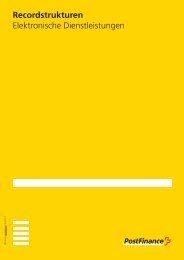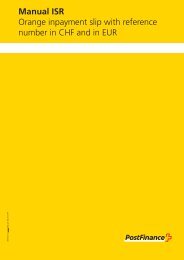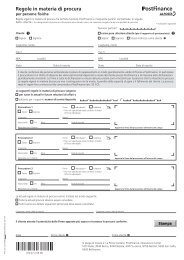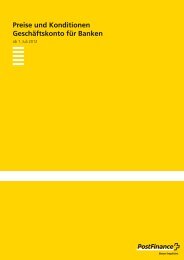Manual E-bill 499.41
Manual E-bill 499.41
Manual E-bill 499.41
You also want an ePaper? Increase the reach of your titles
YUMPU automatically turns print PDFs into web optimized ePapers that Google loves.
14. Sending orders<br />
14.1 Sending orders to PostFinance<br />
Orders are transferred to PostFinance in an agreed format. PostFinance<br />
provides a suitable web service for this.<br />
On receipt, the orders are given the status “Received”. By means of a return<br />
code, the ordering party can verify that the transfer has been successful.<br />
The processing status can be ascertained by querying the order status. If the<br />
transfer was not successful, the orderer must resend the data.<br />
PostFinance ensures that an order can be received and forwarded only once.<br />
The order number serves as the unique reference for this.<br />
PostFinance temporarily stores the order for seven days. It is possible to<br />
check the order status during this period. The orders are then deleted.<br />
14.2 Sending orders to suppliers<br />
An order is delivered to a supplier using an agreed format and channel,<br />
i. e. it is possible for the data to be converted from the orderer’s format into<br />
the supplier’s format.<br />
Order confirmations and other messages cannot be sent via PostFinance.<br />
14.3 Order status<br />
The order status can be checked using a web service. This is made available<br />
with the following structure:<br />
• Order number<br />
• Status (received, delivered)<br />
• Timestamp<br />
For further information about sending orders, please contact the specialists<br />
at the e-<strong>bill</strong> helpdesk.<br />
<strong>Manual</strong> E-<strong>bill</strong> Version October 2010 56/64

















